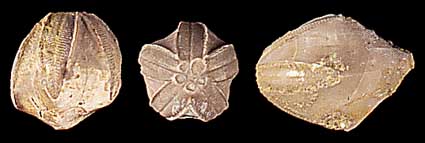
Pentremites, a common Missisiippian Blastoid, image
shown
with permission from
the University of California Museum of Paleontology
Invertebrate Paleontology Lab #11
Phylum
Echinodermata
Click on the lab title to see the University of
California
Museum of Paleontology web page
Read BEFORE Coming to Lab: Benton & Harper, p. 389-409
Introduction
This week we will explore the very diverse and
successful
Echinoderm
Phylum. The five living classes of echinoderms today include
the sea stars, brittle stars, sea urchins, crinoids and sea cucumbers,
but abundant as these are, they represent just a remnant of an immense
group that once included 20 different classes. The organisms are
perhaps best known for their water vascular system, which
operates
the tube feet as well as governs gas exchange and feeding
processes.
Echinderms also have an endoskeleton, composed of many little
plates
that can articulated or fused together. These plates are called ossicles,
and are embedded in the dermal tissue. The endoskeleton assures a
good chance for fossilization, because it is these ossicles that are
often
preserved in the fossil record.
Echinoderms have a remarkable feature that is
unique
in the animal kingdom: they can reverse the rigidity of their
dermal
cells and connective tissue. This is most evident, for example,
in
the action of a starfish as it attacks a pelecypod. The
connective
tissue stiffens, and provides a framework against which the tube feet
can
pull as the pelecypod's valves are forced open. Later, the
starfish
can soften the connective tissue, return to its flexible condition, and
move away. Apparently, the ability to reversibly affect the
rigidity
of the dermal and connective tissue is directly related to controlling
the concentration of calcium ions in the tissues. To read more
about
this interesting feature, I recommend Ruppert et al. (2004) (reference
is below).
Basic Facts to Know about
Echinoderms: They are |
|
| 1. |
Eukaryotes |
| 2. |
Metazoans with organs, true tissues, nervous, muscular,
and reproductive
systems |
| 3. |
characterized by an endoskeleton composed of ossicles
(calcite plates) that can be articulated or fused |
| 4. |
characterized by unique ability in the Animal
Kingdom to reverse
the rigidity of their connective tissue |
| 5. |
characterized by radial symmetry, often visible as pentameral
(5-rayed) in some groups |
| 6. |
characterized by an internal water vascular system that
operates
movement, feeding, gas exchange |
| 7. |
limited to marine environments only because of lack
of osmotic
regulation |
| 8. |
Excellent index fossils: widely distributed,
well preserved,
easily identified, rapidly evolving |
| 9. |
found to filter feed, or to be heribivores, predators,
scavengers,
and detritivores |
| 10. |
gonochoric (males and females present, with a few
exceptions)
and larvae have a planktonic phase |
Crinoids, Blastoids, and other Stalked Echinoderms
Class Crinoidea (Cambrian to Recent)
The Crinoids represent the only living group of
stalked echinoderms still in existance. They have a fossil
history
that extends into the Middle Cambrian Burgess Shale. The crinoid
body consists of a calyx or theca, which houses the internal
organs
and bears the arms which are used for feeding. Attached to the
theca
is a stalk or column that consist of disks of calcite
columnals,
pierced through the center by a fibrous mass of collagen. The
stalk
is anchored to the substrate with a holdfast, which looks very
similar
to plant roots. Upon death, the collagen breaks down and the
columnals
are released like beads from a broken necklace. If wave energy is
slight, the column is likely to stay more or less intact, however, any
wave action or current action will scatter the columnals, and often in
the fossil record, a columnal hash deposit results. Like all
echinoderms,
they have endoskeletal ossicles, and a water vascular system that
operates
the feeding arms. The arms have ambulacral food grooves
that
move food towards the mouth, which is in the center of the calyx
(theca).
The arms extend into the water current, trap food particles which move
via mucus along the ambulacral grooves to the mouth. The gut is a
simple loop that terminates in the anus, which is next to the mouth on
the top of the calyx. The arms were strong, containing extensions
of the coelem, and are often preserved.
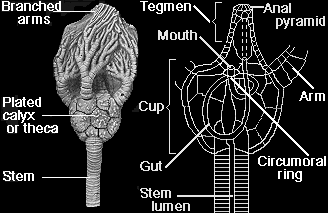
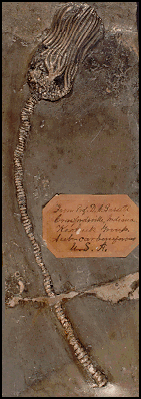
Figures of Crinoid Terminology and fossil Crinoid shown with permission
from the University of California Museum of Paleontology
Class Blastoidea (Middle Ordovician-Late Permian)
The Blastoids are the second most common group of
stalked echinoderms. The calyx of blastoids shows a strong
pentameral symmetry, and looks like a nut or the bud of a flower.
The arms were very delicate, with no coelemate extension, and are not
usually
preserved. The mouth is a simple opening located in the center of
the top of the calyx, and surrounded by typically five circular
openings
called spiricles that apparently served as the exhalent currents.
These openings can be clearly seen in the photo below, where the center
view shows the star-shaped opening that is the mouth, and the
surrounding
spiricles. The largest of the spiricles is the anal opening (the
anispiricle). In side view of the calyx, you can see the
ambulacra,
where the arms (brachioles) would have attached.

Calyx View of Pentremites, a common Blastoid of the Mississippian,
shown with permission from
the University of California Museum of Paleontology
Part I, 20 pts. : Examine the Blastoids and
Crinoids in the Teaching
Collection, and
draw two of these, labelling the calyx, the spiricles (if visible), the
ambulcra, and the columnals (if present). Label the top (oral
side)
and the bottom (aboral side) of the calyx. Label the class and
time
range, as well.
Examine the teaching
collection and pick two non-stalked
echinoderms.
Draw them, labelling the madrepore, the ambulacral area, and the
mouth.
Label the Class and time range, as well.
|
Brittle Stars, Starfish, Edrioasteroids
Class Asteroidea (Early Ordovician-Recent) (Starfish)
The "starfish" appears a early as the Ordovician, and became an
important
predator through the Phanerozoic. They are not typically well
preserved,
because the ossicles are very tiny and not articulated together.
Often star fish have five arms, with the tube feet running along the
ambulacral
arms. The mouth is located on the underside of the starfish, and
the anus and madreporite (the main water entry control for the
water
vascular system) is located on the top. The starfish are able to
evert their stomachs and digest their victim within its own
shell.
There is quite a bit of discussion in the literature concerning the
role
starfish played in the development of complex hinges and commisures in
the mollusks, in the collapse of the brachiopods in the Mesozoic, and
their
role as prolific predators in the Mesozoic marine revolution.
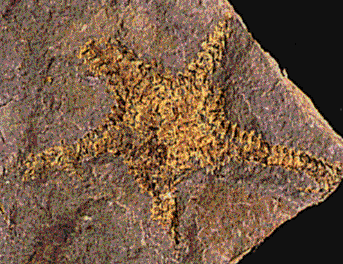
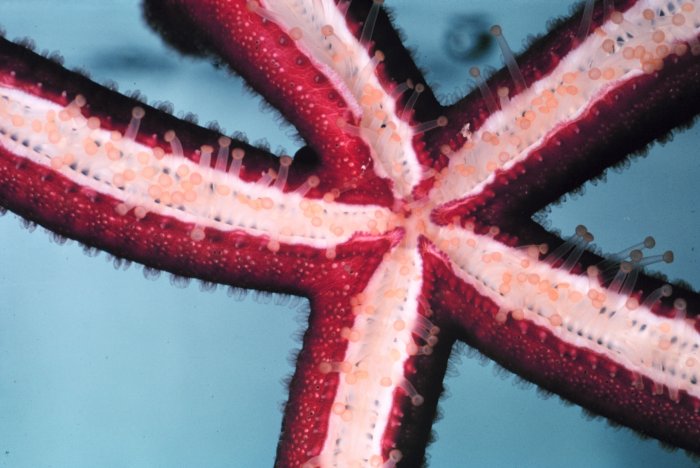
Image of fossil starfish shown with permission from the University
of California Museum of Paleontology, live starfish showing underside
with
tube feet visible, shown courtesy of NOAA NURP, Image ID: reef0206, The
Coral Kingdom Collection Credit: Photo Collection of Dr. James P.
McVey,
NOAA Sea Grant Program
Class Ophiuroidea (Early Ordovician - Recent) (Brittlestars)
Similar to starfish, ophiuroids (brittlestars) typically have five
arms, but these tend to be very thin arms, radiating from a central
disk.
The mouth is located on the underside of the disk-body, and the anus
and
madreporite on the top. However, there is no coelomate extension
through the arms, as in the starfish, and so the primary use of the
arms
is in wriggling about to provide locomotion for the brittlestar.
They are a major component of the deep ocean floor benthos-very few
species
live in shallow waters today.
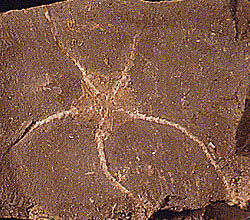
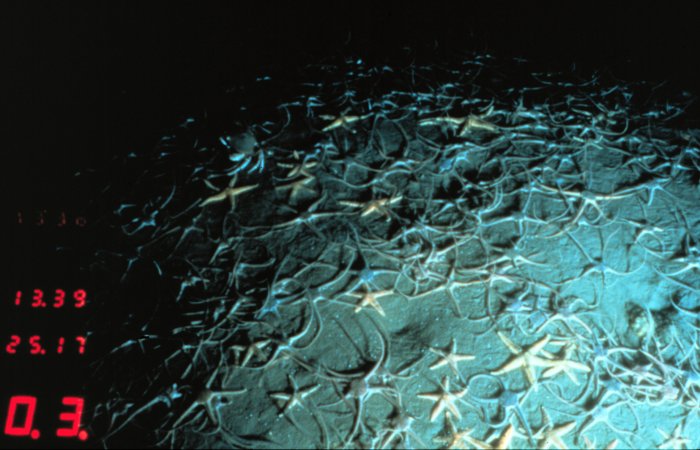
Image of fossil brittlestar shown with permission from the University
of California Museum of Paleontology, image of live brittlestars on the
floor of the deep ocean shown courtesy of NOAA NURP.Image ID: nur01504,
Photographer: S. Stancyk Credit: OAR/National Undersea Research
Program
(NURP); University of South Carolina
Class Edrioasteroidea (Early Cambrian-Late Pennsylvanian)
This interesting group consisted of small (about 1 cm diameter)
circular
shaped animals that attached to hard surfaces. On the top surface
is an arrangement of five loosely coiled or curving ambulacral
arms.
The tube feet caught food particles and transported them to the
mouth.
They are fairly common in the Cincinattian limestones of the
Ordovician,
so you may have collected some in your own samples. They are
often
found cemented onto brachiopods, particularly strophomenid brachiopod
valves.
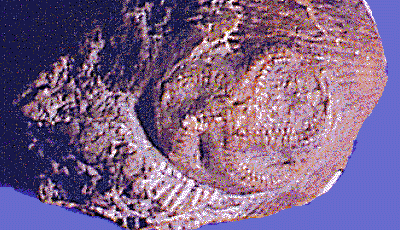
Image of fossil Edrioasteroid shown with permission from the University
of California Museum of Paleontology
Sea Urchins, Sand Dollars, Sea Biscuits, Heart
Urchins
Class Echinoidea (Late Ordovician-Recent)
As a group, echinoids tend to be found as fossils more commonly than
the other echinoderms. This is because the ossicles are fused
together
to make a strong structure that is often preserved in the burrows in
which
the animal lived. The mouth is on the underside, the anus is
located
on the top, near the madreporite plate, and there are typically five
ambulacral
grooves where the tube feet are located. The tube feet vary
considerably.
The tube feet on the bottom are designed for locomotion, whereas those
on the top are for respiration, and there are also long stalks with
grasping
claws called pedicellaria that remove debris and protect the echinoid
from
smaller organisms. All echinoids possess spines, which
are
composed of single crystalline masses of calcite. The spines can
pivot at the base, and thus move in different orientations. There
are two major groups to consider:
The Regular Echinoids (Late Ordovician-Recent)
This group includes the the sea urchins, which have
a radial symmetry, feed on algae by scraping it off rocks with a
feeding
structure called Aristotle's lantern, and have a fossil record
that
extends back to the Ordovician.

Regular Echinoid sea urchin, photo courtesy of NOAA NURP Credit: Photo
Collection of Dr. James P. McVey, NOAA Sea Grant Program
The Irregular Echinoids (Jurassic - Recent)
This group includes the sand dollars, sea biscuits,
and heart urchins. The irregular echinoids are marked by a
secondary
bilateral symmetry, as the whole body is flattened, and consequently
the
anus moved towards the posterior of the shell, and the mouth stayed
central
or moved towards the anterior. Most irregular echinoids burrow,
and
thus have limited ambulacral areas (just on the top of the
shell).
Food grooves with tube feet move food particles along on the underside
of the shell towards the mouth. An extreme body design of
this
group is the flat sand dollar, which first appeared in the early
Tertiary,
and which has slits or lunules in the shell to prevent it from
being
lifted out of the sediment by wave action while it is feeding.
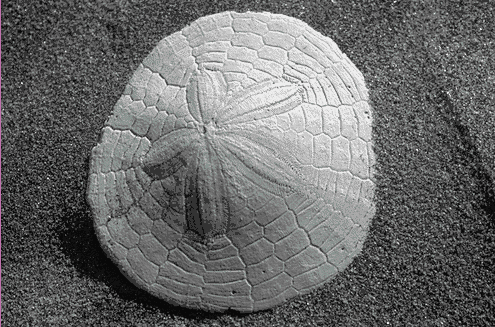
Sand Dollar Image shown with permission from the University of
California
Museum of Paleontology
For More Information...
For more on the fascinating biology of this group, I recommend
Ruppert, Fox and Barnes, 2004 Invertebrate Zoology, , 7th edition,
Chapter 28, Echinodermata, pp. 872-929.









